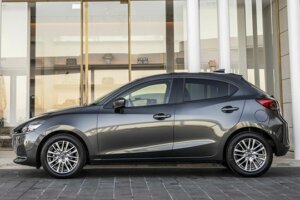
Toyota’s brand approach for Kenya was based on availability and cost-effectiveness. Over the years, the market became exposed to new options from Nissan and, more recently, Mazda. Mazda followed an aggressive marketing strategy offering different models for most best-selling segments. For example, the Mazda 2 or Demio targeted the subcompact sector while the CX5 and CX3 filled the compact SUV segments.
Here are some of the Mazda models on the market:
Mazda CX-5
Significant competitors from Toyota include the RAV-4 and the Toyota Rush. Released in 2013, the CX-5 was stylistically superior to the Toyota offerings considering the modern front fascia and slightly imposing size. Mazda also availed the CX-5 with the sky-active engine, which provided better power for the same engine capacity. The 2.0 litre from Toyota managed 176 horsepower while the same model year CX-5 was capable of 187 horsepower. It was also fairly priced at Ksh 2 million, which is relatively affordable considering the segment.
Aside from an excellent driving experience and great fuel economy, the CX-5 also has an elegant interior. For an SUV, the steering response is impressive and feels more connected than most rivals. That being said, the CX-5 also has disadvantages. The diesel engines, for one, tend to overheat from blown head gaskets and diesel particulate filter issues.
Mazda Atenza
The Atenza is built as a sleek, sporty front-wheel drive sedan, with curvy aesthetics and 2.5-litre turbocharged four-cylinder engine. Its rival, the Premio, has a 1.8-litre four-cylinder unit and does not have a diesel engine option. From a performance perspective, the Atenza outclasses the Premio in various areas, including handling and response. The Atenza also avails a six-speed manual or automatic transmission as opposed to the Premio’s CVT. The few potentially problematic components in an Atenza include the mass air flow sensor and ignition coils. However, these are minor compared to the potential problems of similarly-sized Toyota models.
Mazda Demio
Toyota Vitz has been quite dominant in the Kenyan market but now faces stiff competition from Mazda Demio. Mazda improved the exterior design of the 2nd-generation Demio, making it sleeker and more desirable with its narrow headlights and bolder lines and curves. Like the Vitz, the Demio serves the rideshare and youth markets. Its price advantage and competitive fuel economy make it a go-to option for first-time car buyers.
Also, the wide-scale availability of Demios makes it easy to maintain them in Kenya. Demio parts and accessories are easy to find in most major Kenyan towns and are also affordable. Also worth noting is that CMC Motors is listed as the official distributor in the country, so it is possible to purchase a zero-mileage model.
A Paradigm Shift from ‘The Car in front is always a Toyota’ Culture
For many years, Toyota’s ‘The Car in front is always a Toyota’ slogan was a true reflection of Toyota’s dominance in the Kenyan market. Toyota vehicles have always been loved for
their reliability, capability, and resilience. However, it is apparent that car-buying preferences in Kenya are shifting. More and more, Kenyans are taking notice of other car brands that offer similar yet more affordable variants with better comfort, performance, safety, practicality, and capability.
Effect of the Covid19 Pandemic
During the onset of the Covid19 pandemic, the pricing of vehicles also jumped significantly due to supply chain disruptions. It resulted in popular Toyota models like the Harrier and Premio going up in pricing by Ksh. 150,000 to Ksh. 400,000, from April to December 2020. Unfortunately, customers opted to consider other models hence the increasing purchase of Mazda models.
Power of internet
The globalization of the automotive industry has changed the Kenyan automotive market. Most of the available brands were local or regional, hence Toyota’s domination. Most Kenyan buyers opted for Toyota because they were not exposed to the benefits of other brands. Mazda, for one, was perceived as a niche brand. During the past decade, though, international car manufacturers have set up operations in Kenya and employed digital campaigns to widen their reach. This has exposed the consumer base to the wide range of options and available features. Mazda has also restructured its image to market to the younger, more affluent, diverse base. They have since become more exciting and exotic as a purchase option, which is more appealing than Toyota’s functional or affordable.
Pricing Strategy
As the automotive industry is increasingly becoming competitive, Mazda has preferred pricing the models according to the competition within each segment. For example, the 2015 CX-5 may retail at Ksh 2.2 million while its competitor, the Rav 4, is priced at Ksh 2.5 million. Similarly, the 2015 Vitz costs Ksh. 1.1 million, though the same year, Demio is rated at Ksh 1.2 to 1.3 million.
Mazda is taking advantage of a change from the old guard considering functional and affordable are no longer significant criteria to attract the target market. It is representative of new trends from a budding customer base that prioritizes quality above the ability to move from one point to the other. Mazda’s pricing strategy has also been intelligent enough to seem attractive compared to Toyota’s yearly offerings.

I have been surfing online more than 3 hours today yet I never found any interesting article like yours It is pretty worth enough for me In my opinion if all web owners and bloggers made good content as you did the web will be much more useful than ever before
Thank you so much for your kind words! I’m thrilled to hear you found the content valuable. It’s always my goal to create something meaningful and engaging for readers like you. Your encouragement truly motivates me to keep improving and sharing more! If there’s any topic you’d like to see covered, feel free to share—I’d love to hear your thoughts!